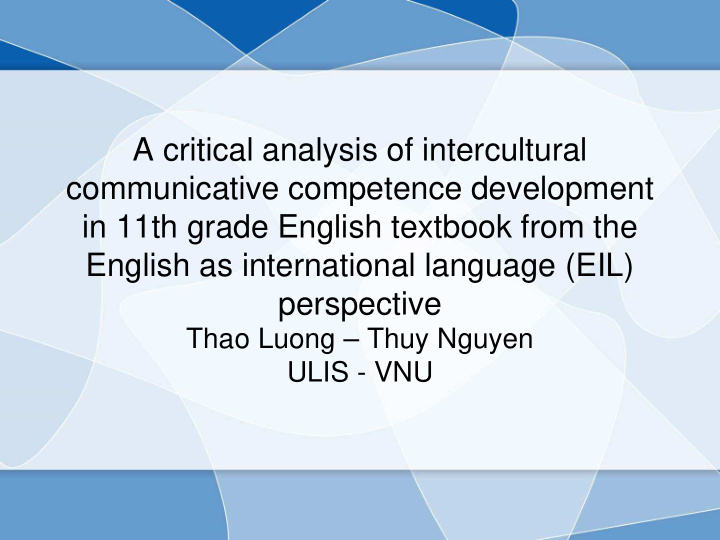



A critical analysis of intercultural communicative competence development in 11th grade English textbook from the English as international language (EIL) perspective Thao Luong – Thuy Nguyen ULIS - VNU
Background: Kachru’s three concentric model of the spread of English (1985) Non-native speakers of English now Vietnam outnumber native speakers by approximately 3 to 1
• the native speaker norms in both linguistic and cultural competence are no longer appropriate. develop intercultural communicative competence that enables students to relativize their own cultural values, beliefs and behaviors, and investigate for themselves the otherness - what is different to their “norm ”
• should not teach their students only Anglo- American culture Other critical Ss’ own culture cultural culture s awareness Comparison and contrast
Aims of the study • critically analyzing to what extent the textbook “English Grade 11 can foster students’ intercultural competence and critical awareness in the context of teaching English as an international language in Vietnam • Textbook analysis frameworks: content analysis + evaluation of teaching methods.
Content analysis • The majority of topics for reading or listening passages in all units are the cultural issues in Britain and America past experiences of a Western birthday party and wedding girl called Christina (unit 2) anniversaries in US (unit 3) volunteer work by high school London and Boston marathon and college students as (unit 6)… volunteer in the US (unit 4) etc • The number of topics related to Vietnam ranks second • The most marginalized cultures are those of other countries in the same region with Vietnam such as Japan and China
Anglo-centric focus • is also reflected in the content of reading passages or language expressions used in speaking activities • E.g. • speaking task in unit 1. • some language expressions given to students are more suitable for describing Western people: square face, a straight, crooked nose, very few expressions to describe typical Asian features: broad nose, double or single eyelid…
• the discourse conventions in conversations or writing tasks strictly follow those of English speaking countries • WRITING • Task 1. Read the letter and underline the sentences that express the following points: •
• Ideal representation of English speaking countries like Britain and America: an urbanized, affluent culture of middle class • Vietnamese cultures, particularly the cultures of ethnic minority students in rural areas in Vietnam are not adequately presented in the textbook: mostly portrays the images of urbanized and rich people
Analysis of teaching methods • cultural issues are presented in isolation and leave few possibilities for comparison • few activities to help students avoid stereotypes and become aware that there are many ways of doing things and their way is not the only possible one. • Students are required to passively read a text and or listen to listening passages and then answer only factual questions • speaking activities: Ss are expected to imitate a sample dialogue and use prescribed language expressions. few chances for them to reflect and make a comparison and contrast between their home culture and other foreign culture
Implications • include greater diversity of cultural issues, and portray both positive and negative aspects of target and source culture • design more activities that leaves opportunities for students to critically reflect on the target culture and their home culture: cultural assimilators, role-play, discussion, etc.
References • Aguilar, M. J. C. (2007). Dealing with Intercultural Communicative Competence in the Foreign Language Classroom. In E. A. Soler & M. P. S. Jordà (Eds.), Intercultural Language Use and Language Learning (pp. 59- 78): Springer Netherlands. • Baladi, N. (2007). Critical pedagogy in the ELT industry: can a socially responsible curriculum find its place in a corporate culture? Unpublished master’s thesis, McGill University, Montreal, Canada. Retrieved May 30, 2011, from http://digitool.library.mcgill.ca/thesisfile18457.pdf • Cortazzi, M & Jin, L. (1999), Cultural Mirrors. Materials and Methods in EFL Classroom. In E. Hinkel (ed.), Culture in Second Language Teaching and Learning , Cambridge: Cambridge University Press • Dunnet, S. C., Dubin, F. & Lezberg, A. (1986), English Language Teaching from an Intercultural Perspectives, In Valdes, J. M. (ed.), Culture Bound , Cambridge: Cambridge University Press. • Hue, L.T., & Khanh, T. T. (Eds.). (2010). Engish 11 . Hanoi: Education Publishing House- Ministry of Education and Training. • Pica, T. (1994). Questions from the Language Classroom: Research Perspectives. TESOL Quarterly, 28(1): 49-79. • McKay, S.L. (2002). Teaching English as an International Language: Rethinking Goals and Approaches . Oxford : Oxford University Press. • Tang, R. (1999). The place of "culture" in the foreign language classroom: A reflection. The Internet TESL Journal, 8 . Retrieved from http://iteslj.org/Articles/Tang-Culture.html
Recommend
More recommend